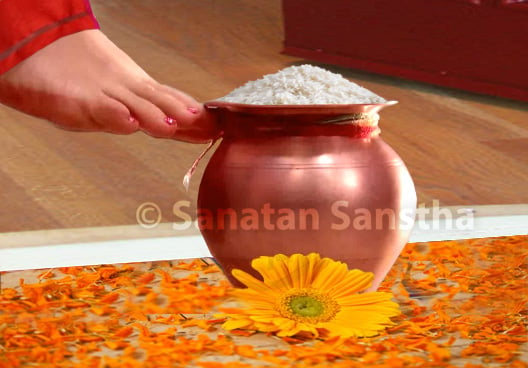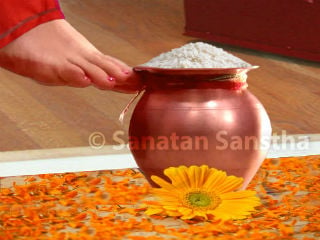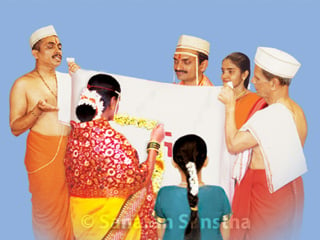Hindu Dharma has advised sanskars to be performed during the sixteen principal events of life, so as to move closer to God. The most important of them being the ‘Vivahasanskar (Marriage sanskar)’! The true objective of a marriage is that two individuals seek the blessings of God to lead a compatible and happy married life! For this, it is absolutely essential to perform the ritual of marriage strictly as per the scriptures. This article explains the rituals to be performed after marriage.
1. Vadhu griha-pravesh

As soon as the marriage procession enters the house of the groom, balls of rice mixed with curd or a piece of bhakri (Bharatiya bread) is waved over the newlyweds (to cast off the evil eye). The bride enters the groom’s home by toppling (with her right foot) the tumbler of rice grains placed on the threshold of the main door. This ritual is called as vadhu griha-pravesh. Then, Lakshmi-pujan is performed and the bride is given a new name.
A. Science underlying toppling of the tumbler by the bride
When the bride entering the house topples the tumbler of rice grains with her right foot, marak (Destroyer) waves emitting from her foot spread in the rice grains in the tumbler. The marak sound waves resulting from the action of toppling the tumbler are emitted into the environment through the medium of rice grains. As a result, distressing waves in the house are displaced and the environment in the house gets charged with Chaitanya (Divine consciousness). Deities are pleased with such an environment and it helps in obtaining their grace quickly. Through the ritual of ‘toppling the tumbler’, in a way the Kriya-shakti (Energy of action) of Shri Durgadevi in the Universe is awakened and is offered a prayer to remain functional through the medium of the bride, thereby entrusting her with the responsibility of the entire family.
2. The rituals on the days following the marriage
Following rituals are performed after the day of the marriage. Gruhapraveshniya hom, Vadhu-var vrat, the ritual of Sunmukh, the ritual of Airinidan, taking the idol of Annapurna and Gondhal dance. (It is a custom in some houses to perform Gondhal after the marriage.)
Devakotthapan and mandapodvasan : After the conclusion of the auspicious function the Deities are bid farewell.
Reference : Sanatan Sanstha’s Holy text ‘Marriage sanskar’


 Spiritualize every act performed in a Hindu Marriage ceremony !
Spiritualize every act performed in a Hindu Marriage ceremony ! Danger of collapse of the family system due to the resulting immorality !
Danger of collapse of the family system due to the resulting immorality ! Kanyadan
Kanyadan